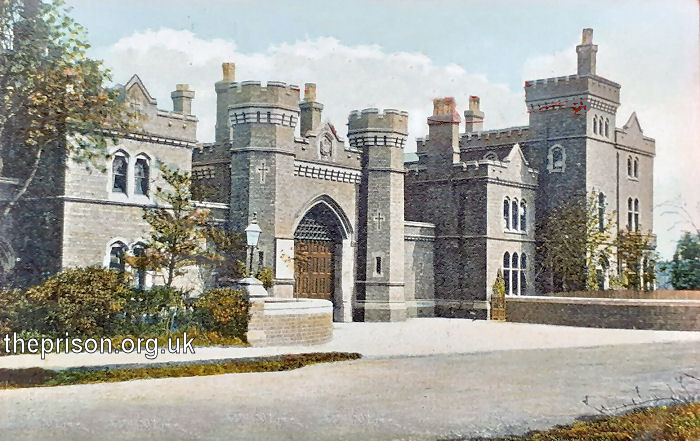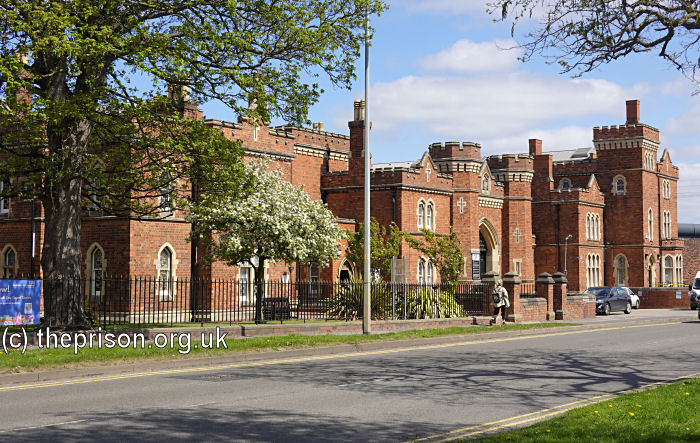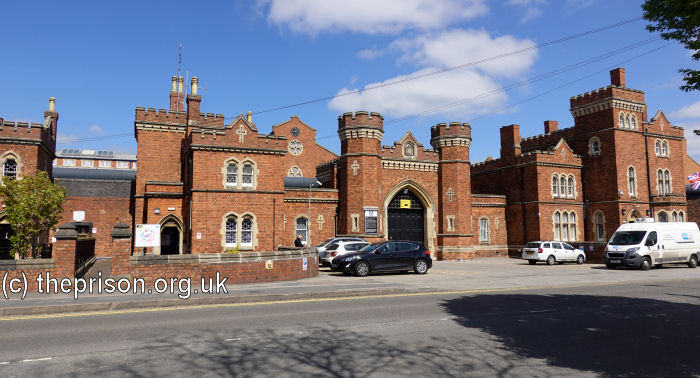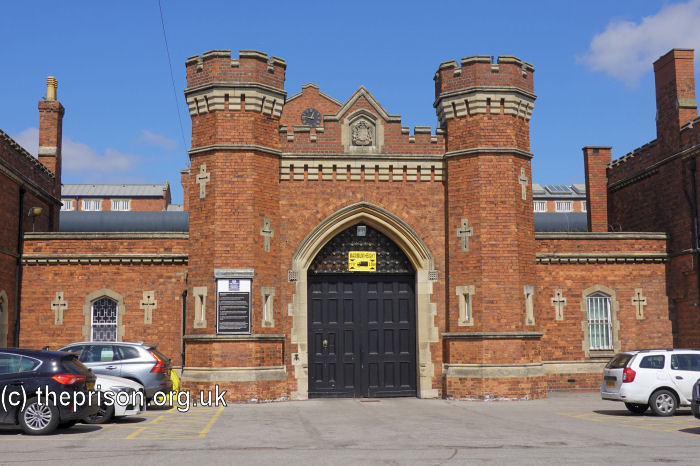Lindsey County Gaol / HMP Lincoln, Lincoln, Lincolnshire
A County Gaol serving the Lindsey division of Lincolnshire was erected in 1868-72 on ay 13-acre site on Greetwell Road, Lincoln. Its opening allowed the closure of three other Lindsey prisons — the Houses of Corrction at Louth, Kirton and Spilsby.
The buildings, constructed in red brick, were designed by Frederick Peck to house 213 inmates under the 'separate' system. The entrance block on Greetwell Road had a typical large gateway with castellated towers at either side. The Gatekeeper's and Chief Warder's houses were on the left and the Governor's house on the right. The main building had a radial-style layout with two four-storey cell wings. That for males ran west from the central hall, and the shorter one for females ran to the east. Unusually, the cell wings had clerestory windows above the corridors, and had lean-to rather than flat roofs above the cells. A third wing, to the south, contained the men's reception, offices, and a chapel above, which was large enough to hold all the inmates. Four warders' quarters were provided in a row of stone cottages at the north-west of the site.
Following the nationalisation of the prison system in 1878, the gaol became Her Majesty's Prison, Lincoln.
Various additions were subsequently made to the buildings. By 1878, the west wing had been increased in length from 12 to 19 cells along its length. A block for juvenile adults was later added at the end the east wing. Lincoln Borstal Institution operated in this part of the prison between 1906 and 1908.

Lindsey County Gaol / HMP Lincoln,c.1906. © Peter Higginbotham

Lindsey County Gaol / HMP Lincoln, 2022. © Peter Higginbotham

Lindsey County Gaol / HMP Lincoln, 2022. © Peter Higginbotham

Lindsey County Gaol / HMP Lincoln, 2022. © Peter Higginbotham
In October 2002, inmates rioted and gained control of one section of the prison for several hours, also setting fire to parts of the building.
The establishment is now a Category B local prison, holding adult male remand and convicted prisoners from courts in Lincolnshire, Nottinghamshire and the East Riding of Yorkshire
Records
Note: many repositories impose a closure period of up to 100 years for records identifying individuals. Before travelling a long distance, always check that the records you want to consult will be available.
- Lincolnshire Archives, St. Rumbold Street, Lincoln LN2 5AB. Holdings include: Register of inmates requiring medical treatment (1872-8); Recommittal list(1878-83); Nominal record (1877-9); Copy of Capital Punishment Amendment Act 1868 with notes on executions at Lincoln Castle and Lincoln Prison (1868-91); Record of executions in Lincoln Prison (1897-1961); Loose papers, relating to executions and graves (1883-1987); Glass negatives, with shots of prisoners (late 19C - early 20C).
- The National Archives, Kew, Richmond, Surrey, TW9 4DU. Holdings include: Register of prisoners (1872-3).
- Find My Past has digitized many of the National Archives' prison records, including prisoner-of-war records, plus a variety of local records including Manchester, York and Plymouth. More information.
- Prison-related records on
Ancestry UK
include Prison Commission Records, 1770-1951
, and local records from London, Swansea, Gloucesterhire and West Yorkshire. More information.
- The Genealogist also has a number of National Archives' prison records. More information.
Census
Bibliography
- Higginbotham, Peter The Prison Cookbook: A History of the English Prison and its Food (2010, The History Press)
- Brodie, A. Behind Bars - The Hidden Architecture of England's Prisons (2000, English Heritage)
- Brodie, A., Croom, J. & Davies, J.O. English Prisons: An Architectural History (2002, English Heritage)
- Harding, C., Hines, B., Ireland, R., Rawlings, P. Imprisonment in England and Wales (1985, Croom Helm)
- McConville, Sean A History of English Prison Administration: Volume I 1750-1877 (1981, Routledge & Kegan Paul)
- Morris, N. and Rothman, D.G. (eds.) The Oxfod History of the Prison (1997, OUP)
- Pugh R.B. Imprisonment in Medieval England (1968, CUP)
Links
- Prison Oracle - resources those involved in present-day UK prisons.
- GOV.UK - UK Government's information on sentencing, probation and support for families.
Except where indicated, this page () © Peter Higginbotham. Contents may not be reproduced without permission.



